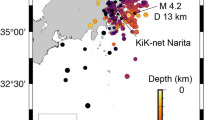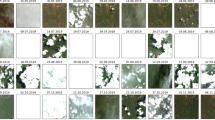Abstract
An automated signal-based method was developed in order to analyse the seafloor backscatter data logged by calibrated multibeam echosounder. The processing consists first in the clustering of each survey sub-area into a small number of homogeneous sediment types, based on the backscatter average level at one or several incidence angles. Second, it uses their local average angular response to extract discriminant descriptors, obtained by fitting the field data to the Generic Seafloor Acoustic Backscatter parametric model. Third, the descriptors are used for seafloor type classification. The method was tested on the multi-year data recorded by a calibrated 90-kHz Simrad ME70 multibeam sonar operated in the Bay of Biscay, France and Celtic Sea, Ireland. It was applied for seafloor-type classification into 12 classes, to a dataset of 158 spots surveyed for demersal and benthic fauna study and monitoring. Qualitative analyses and classified clusters using extracted parameters show a good discriminatory potential, indicating the robustness of this approach.









Similar content being viewed by others
References
Akaike H (1973) Information theory and an extension of the maximum likelihood principle, [w:] proceedings of the 2nd international symposium on information, bn petrow, f. Czaki, Akademiai Kiado, Budapest
Augustin J-M, Lurton X (2005) Image amplitude calibration and processing for seafloor mapping sonars. In: Oceans 2005-Europe. Vol 1. IEEE, pp 698–701
Brown CJ, Blondel P (2009) Developments in the application of multibeam sonar backscatter for seafloor habitat mapping. Appl Acoust 70(10):1242–1247
Brown CJ, Smith SJ, Lawton P, Anderson JT (2011) Benthic habitat mapping: a review of progress towards improved understanding of the spatial ecology of the seafloor using acoustic techniques. Estuar Coast Shelf Sci 92(3):502–520
CARAIBES\(^{{\copyright }}\), 09/01/2018 v5. Ifremer seafloor mapping software. http://flotte.ifremer.fr/fleet/Presentation-of-the-fleet/Logiciels-embarques/CARAIBES
Cutter GR, Berger L, Demer DA (2010) A comparison of bathymetry mapped with the simrad me70 multibeam echosounder operated in bathymetric and fisheries modes. ICES J Mar Sci 67(6):1301–1309
Edwards BD, Dartnell P, Chezar H (2003) Characterizing benthic substrates of santa monica bay with seafloor photography and multibeam sonar imagery. Mar Environ Res 56(1):47–66
EMODnet, 09/01/2018 The home of European seabed habitat maps. (2016)http://www.emodnet-seabedhabitats.eu/default.aspx?mapInstance=MESHAtlanticMap_&page=1974&LAYERS=EUSM2016&zoom=6&Y=44.01531241474476&X=-1.487324218233178
Fonseca L, Brown C, Calder B, Mayer L, Rzhanov Y (2009) Angular range analysis of acoustic themes from stanton banks ireland: a link between visual interpretation and multibeam echosounder angular signatures. Appl Acoust 70(10):1298–1304
Fonseca L, Mayer L (2007) Remote estimation of surficial seafloor properties through the application angular range analysis to multibeam sonar data. Mar Geophys Res 28(2):119–126
Hamilton L, Parnum I (2011) Acoustic seabed segmentation from direct statistical clustering of entire multibeam sonar backscatter curves. Cont Shelf Res 31(2):138–148
Hartigan JA, Wong MA (1979) Algorithm as 136: a k-means clustering algorithm. J R Stat Soc Ser C 28(1):100–108
Hasan RC, Ierodiaconou D, Laurenson L, Schimel A (2014) Integrating multibeam backscatter angular response, mosaic and bathymetry data for benthic habitat mapping. PLoS ONE 9(5):e97339
Hellequin L, Boucher J-M, Lurton X (2003) Processing of high-frequency multibeam echo sounder data for seafloor characterization. IEEE J Oceanic Eng 28(1):78–89
Hughes Clarke J (1994) Toward remote seafloor classification using the angular response of acoustic backscattering: a case study from multiple overlapping gloria data. IEEE J Oceanic Eng 19(1):112–127
Hughes Clarke J, Danforth B, Valentine P (1997) Areal seabed classification using backscatter angular response at 95 khz. In: SACLANTCEN conference on high frequency acoustics in shallow water, pp 243–250
ICES (2016) Final report of the working group on fisheries acoustics science and technology (wgfast). Technology report, Vigo Spain
IHO (2008) IHO standards for hydrographic surveys. Vol. Special publication N 44. International Hydrographic Bureau
Jackson DR, Winebrenner DP, Ishimaru A (1986) Application of the composite roughness model to high-frequency bottom backscattering. J Acoust Soc Am 79(5):1410–1422
Lamarche G, Lurton X, Verdier A-L, Augustin J-M (2011) Quantitative characterisation of seafloor substrate and bedforms using advanced processing of multibeam backscatterapplication to cook strait, new zealand. Cont Shelf Res 31(2):S93–S109
Lurton X (2010) An introduction to underwater acoustics. Principles and applications, 2nd edn. Springer-Verlag, Berlin Heidelberg
Lurton X, Eleftherakis D, Augustin JM (2017) Analysis of seafloor backscatter strength dependence on the azimuthal angle using multibeam echosounder data. Marine Geophysical Research. In: Lamarche G, Lurton X (Eds) Seafloor backscatter data from swath mapping echosounders: from technological development to novel applications, pp 1–21
Lurton X, Lamarche G (2015) Backscatter measurements by seafloor-mapping sonars: guidelines and recommendations. A collective report by members of the GeoHab Backscatter Working Group, pp 79–106. http://geohab.org/publications/
McGonigle C, Grabowski JH, Brown CJ, Weber TC, Quinn R (2011) Detection of deep water benthic macroalgae using image-based classification techniques on multibeam backscatter at cashes ledge, gulf of maine, usa. Estuar Coast Shelf Sci 91(1):87–101
Montereale-Gavazzi G, Roche M, Lurton X, Degrendele K, Terseleer N, Van Lancker V (2017) Seafloor change detection using multibeam echosounder backscatter: case study on the belgian part of the north sea. Marine Geophysical Research, In Lamarche G, Lurton X (Eds) Seafloor backscatter data from swath mapping echosounders: from technological development to novel applications Marine Geophysical Research, pp 1–19. https://doi.org/10.1007/s11001-017-9323-6
Ona E, Mazauric V, Andersen LN (2009) Calibration methods for two scientific multibeam systems. ICES J Mar Sci 66(6):1326–1334
Pirtle JL, Weber TC, Wilson CD, Rooper CN (2015) Assessment of trawlable and untrawlable seafloor using multibeam-derived metrics. Methods Oceanogr 12:18–35
Rousseeuw PJ (1987) Silhouettes: a graphical aid to the interpretation and validation of cluster analysis. J Comput Appl Math 20:53–65
Simons DG, Snellen M (2009) A bayesian approach to seafloor classification using multi-beam echo-sounder backscatter data. Appl Acoust 70(10):1258–1268
SIS (2010) SIS, Seafloor Information System, Kongsberg ME70 Operator Manual. Kongsberg Maritime
SonarScope®, 09/01/2018 v2017. Ifremer acoustic system analysis software. http://flotte.ifremer.fr/fleet/Presentation-of-the-fleet/Logiciels-embarques/SonarScope
Trenkel VM, Mazauric V, Berger L (2008) The new fisheries multibeam echosounder me70: description and expected contribution to fisheries research. ICES J Mar Sci 65(4):645–655
Acknowledgements
This project was partially funded by SHOM (Service Hydrographique et Océanographique de la Marine, France) under contract 14CR02. The work was conducted in the framework of the Ifremer RD project R403-006 “Underwater Acoustics”. Dr Pascal Laffargue is in charge of the EVHOE data collection with ME70 Thalassa on RV Thalassa; he is gratefully thanked for making available for our study this exceptionally rich dataset. We would like to express our gratitude to Dr Xavier Lurton for his help in writing this paper and many constructive discussions, and Jean-Marie Augustin for his invaluable help for data processing with SonarScope®.
Author information
Authors and Affiliations
Corresponding author
Rights and permissions
About this article
Cite this article
Fezzani, R., Berger, L. Analysis of calibrated seafloor backscatter for habitat classification methodology and case study of 158 spots in the Bay of Biscay and Celtic Sea. Mar Geophys Res 39, 169–181 (2018). https://doi.org/10.1007/s11001-018-9342-y
Received:
Accepted:
Published:
Issue Date:
DOI: https://doi.org/10.1007/s11001-018-9342-y




